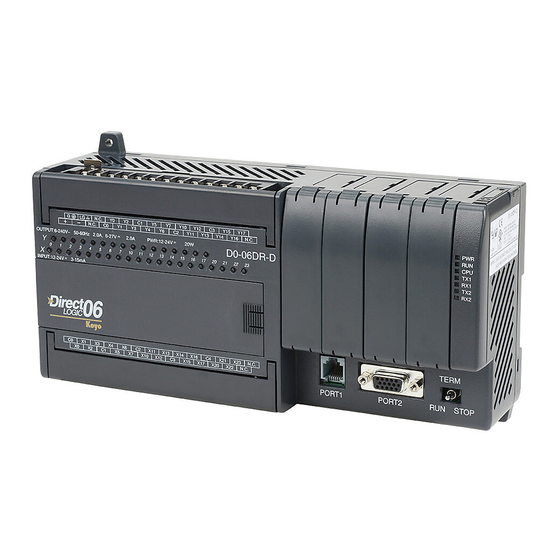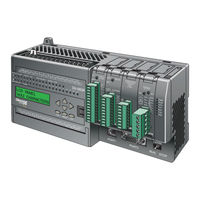
Automationdirect.com DL06 Manuals
Manuals and User Guides for Automationdirect.com DL06. We have 3 Automationdirect.com DL06 manuals available for free PDF download: User Manual
Automationdirect.com DL06 User Manual (382 pages)
Micro PLC
Brand: Automationdirect.com
|
Category: Controller
|
Size: 5 MB
Table of Contents
-
-
Introduction29
-
Introduction30
-
Purpose30
-
-
-
-
-
Loop Alarms91
-
-
PID Loop Tuning118
-
-
Introduction136
-
Ramp/Soak Table137
-
Test the Profile142
-
Cascade Control143
-
Introduction143
-
Bibliography157
-
-
-
-
-
Diagnostics160
-
CPU Indicators164
-
RUN Indicator165
-
Enclosures168
-
-
-
Keypad182
-
-
-
Data Monitor190
-
V-Memory Values190
-
Pointer Values192
-
Bit Monitor193
-
Bit Status193
-
-
-
-
In this Appendix212
-
Introduction212
-
-
-
AUX 83 Lock CPU220
-
DL06 Error Codes221
-
-
-
Introduction228
-
-
Bit Instructions245
-
-
-
-
-
Introduction258
-
-
Purpose263
-
Wiring Diagram264
-
Using Counters279
-
-
-
Wiring Diagram296
-
-
-
DL06 PLC Memory335
-
-
Advertisement
Automationdirect.com DL06 User Manual (533 pages)
Micro Programmable Logic Controller
Brand: Automationdirect.com
|
Category: Controller
|
Size: 12 MB
Table of Contents
-
-
Introduction
31 -
Quick Start
35
-
-
-
-
-
-
Overview
93 -
CPU Operation
103-
Program Mode104
-
Run Mode104
-
Read Inputs105
-
Write Outputs107
-
Diagnostics108
-
-
Memory Map
116 -
DL06 Aliases
122 -
DL06 Memory Map
123 -
-
Module Placement
136 -
Power Budgeting
138 -
-
Example 1: V2100147
-
Example 2: Y20147
-
Example 4: C54147
Automationdirect.com DL06 User Manual (278 pages)
Option Modules
Brand: Automationdirect.com
|
Category: Control Unit
|
Size: 8 MB
Table of Contents
-
-
Introduction
23 -
-
-
-
-
-
-
Module Operation
100 -
-
Analog Data Bits108
-
-
-
Wiring Diagram
116 -
Module Operation
117 -
-
Analog Data Bits125
-
-
-
Wiring Diagram
132 -
Module Operation
133 -
-
Analog Data Bits141
-
-
-
Wiring Diagram
146 -
Module Operation
147 -
-
Analog Data Bits155
-
-
-
Wiring Diagram
160 -
Module Operation
161 -
-
Analog Data Bits169
-
-
-
Wiring Diagram
174 -
Module Operation
175 -
-
Analog Data Bits183
-
-
Wiring Diagram
189 -
Module Operation
190 -
Special Relays
199 -
-
Analog Data Bits201
-
-
Wiring Diagram
208 -
Module Operation
209 -
-
Analog Data Bits218
-
Advertisement
Advertisement
Related Products
- Automationdirect.com DL05
- Automationdirect.com DirectLOGIC DL205 Series
- Automationdirect.com D4-454 PLC
- Automationdirect.com D4-470
- Automationdirect.com DL305
- Automationdirect.com GS1-10P2
- Automationdirect.com GS1-10P5
- Automationdirect.com GS1-20P2
- Automationdirect.com GS1-20P5
- Automationdirect.com GS1-21P0


